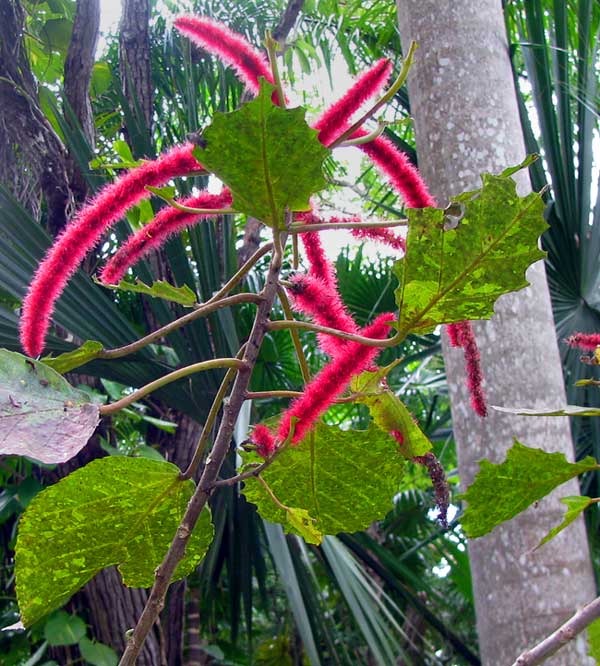Excerpts from Jim Conrad's
Naturalist Newsletter

from the February 28, 2010 Newsletter issued from Hacienda Chichen Resort beside Chichén Itzá Ruins, central Yucatán, MÉXICO; limestone bedrock, elevation ~39m (~128ft), ~N20.676°, ~W88.569°
CHENILLE-PLANTS FLOWERING
In the shadowy garden spaces between Hacienda Chichen's cabins, below the palms and other tall trees, a big-leafed, brittle-stemmed shrub about eight feet tall nowadays is decked with such vibrantly red flower spikes that they seem lit from inside, as shown above.
That's a female Chenille-Plant, also called Redhot-Cattail, Philippines Medusa, Foxtail and a host of other names. It's ACALYPHA HISPIDA, a member of the same family as the Poinsettia, the Spurge Family, the Euphorbiaceae. Chenille-Plants are "dioecious," meaning that each plant bears unisexual flowers of only one gender. In the picture, the long, red spikes, which grow up to 18 inches long (46 cm), bear only female flowers.
The fuzzy appearance is produced by the flowers' long, much-branched styles, the style being the ovary's "neck," which terminates at the top as a pollen-receiving stigma.
Usually Chenille-Plants are propagated by cuttings. Since the inflorescences of male plants aren't regarded as pretty, usually cuttings are made only from female trees.
Chenille-Plants apparently are native to Oceania, though they have escaped in many tropical and subtropical environments.
By the way, chenille is defined as a soft, tufted cord of silk, cotton, or worsted used in embroidery or for fringing, or else a fabric made of this cord, commonly used for bedspreads or rugs.